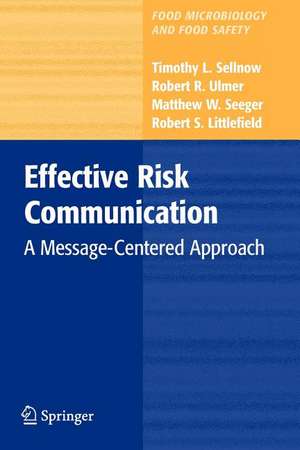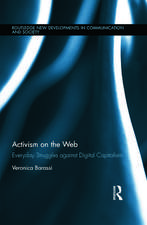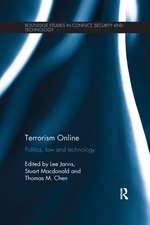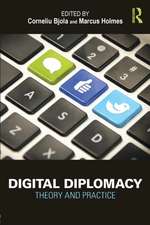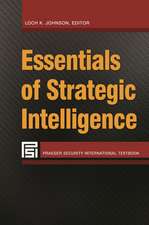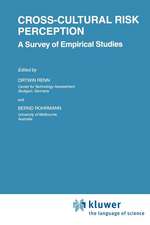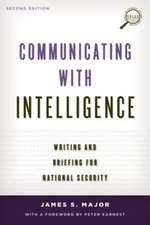Effective Risk Communication: A Message-Centered Approach: Food Microbiology and Food Safety
Autor Timothy L. Sellnow, Robert R. Ulmer, Matthew W. Seeger, Robert Littlefielden Limba Engleză Paperback – 19 noi 2010
| Toate formatele și edițiile | Preț | Express |
|---|---|---|
| Paperback (1) | 382.57 lei 43-57 zile | |
| Springer – 19 noi 2010 | 382.57 lei 43-57 zile | |
| Hardback (1) | 389.70 lei 43-57 zile | |
| Springer – 20 oct 2008 | 389.70 lei 43-57 zile |
Din seria Food Microbiology and Food Safety
- 18%
 Preț: 1396.43 lei
Preț: 1396.43 lei - 20%
 Preț: 565.92 lei
Preț: 565.92 lei - 18%
 Preț: 1244.89 lei
Preț: 1244.89 lei - 15%
 Preț: 639.73 lei
Preț: 639.73 lei - 18%
 Preț: 785.86 lei
Preț: 785.86 lei - 15%
 Preț: 709.44 lei
Preț: 709.44 lei - 18%
 Preț: 951.29 lei
Preț: 951.29 lei - 18%
 Preț: 1118.75 lei
Preț: 1118.75 lei -
 Preț: 389.70 lei
Preț: 389.70 lei - 5%
 Preț: 398.11 lei
Preț: 398.11 lei - 15%
 Preț: 633.68 lei
Preț: 633.68 lei - 18%
 Preț: 1384.26 lei
Preț: 1384.26 lei - 18%
 Preț: 1486.83 lei
Preț: 1486.83 lei - 23%
 Preț: 906.42 lei
Preț: 906.42 lei -
 Preț: 389.88 lei
Preț: 389.88 lei - 18%
 Preț: 782.87 lei
Preț: 782.87 lei - 18%
 Preț: 1111.97 lei
Preț: 1111.97 lei - 15%
 Preț: 645.28 lei
Preț: 645.28 lei - 18%
 Preț: 722.58 lei
Preț: 722.58 lei - 18%
 Preț: 771.49 lei
Preț: 771.49 lei - 15%
 Preț: 712.05 lei
Preț: 712.05 lei - 18%
 Preț: 892.42 lei
Preț: 892.42 lei - 18%
 Preț: 1107.73 lei
Preț: 1107.73 lei - 15%
 Preț: 471.53 lei
Preț: 471.53 lei - 18%
 Preț: 1228.29 lei
Preț: 1228.29 lei - 18%
 Preț: 1236.51 lei
Preț: 1236.51 lei - 18%
 Preț: 1388.68 lei
Preț: 1388.68 lei - 5%
 Preț: 718.65 lei
Preț: 718.65 lei - 18%
 Preț: 1217.41 lei
Preț: 1217.41 lei - 18%
 Preț: 1386.92 lei
Preț: 1386.92 lei - 18%
 Preț: 796.76 lei
Preț: 796.76 lei
Preț: 382.57 lei
Nou
Puncte Express: 574
Preț estimativ în valută:
73.20€ • 76.64$ • 60.57£
73.20€ • 76.64$ • 60.57£
Carte tipărită la comandă
Livrare economică 07-21 aprilie
Preluare comenzi: 021 569.72.76
Specificații
ISBN-13: 9781441927255
ISBN-10: 1441927255
Pagini: 200
Ilustrații: XII, 185 p. 18 illus.
Dimensiuni: 155 x 235 x 11 mm
Greutate: 0.29 kg
Ediția:Softcover reprint of hardcover 1st ed. 2009
Editura: Springer
Colecția Springer
Seria Food Microbiology and Food Safety
Locul publicării:New York, NY, United States
ISBN-10: 1441927255
Pagini: 200
Ilustrații: XII, 185 p. 18 illus.
Dimensiuni: 155 x 235 x 11 mm
Greutate: 0.29 kg
Ediția:Softcover reprint of hardcover 1st ed. 2009
Editura: Springer
Colecția Springer
Seria Food Microbiology and Food Safety
Locul publicării:New York, NY, United States
Public țintă
Professional/practitionerCuprins
Conceptualizing a Message-Centered Approach to Risk Communication.- Introducing a Message-Centered Approach to Risk Communication.- Best Practices for Risk Communication.- Multiple Audiences for Risk Messages.- Cases in Risk Communication.- The Case Study Approach.- Cryptosporidium: Unanticipated Risk Factors.- Hurricane Katrina: Risk Communication in Response to a Natural Disaster.- New Zealand Beef Industry: Risk Communication in Response to a Terrorist Hoax.- Odwalla: The Long-Term Implications of Risk Communication.- ConAgra: Audience Complexity in Risk Communication.- Applications of a Message-Centered Approach to Risk Communication.- Toward a Practice of Mindfulness.- Ethical Considerations in Risk Communication.- Future Directions.
Notă biografică
Timothy L. Sellnow is a Professor Risk Communication in the Department of Communication at the University of Kentucky, Lexington, Kentucky.
Robert R. Ulmer is a Professor of Communication and Chair in the Department of Speech Communication at the University of Arkansas--Little Rock, Little Rock, Arkansas.
Matthew Seeger is a Professor of Communication and Chair in the Department of Communication at Wayne State University, Detroit, Michigan.
Robert S. Littlefield is a Professor Communication in he Department of Communication at North Dakota State University, Fargo, North Dakota.
Robert R. Ulmer is a Professor of Communication and Chair in the Department of Speech Communication at the University of Arkansas--Little Rock, Little Rock, Arkansas.
Matthew Seeger is a Professor of Communication and Chair in the Department of Communication at Wayne State University, Detroit, Michigan.
Robert S. Littlefield is a Professor Communication in he Department of Communication at North Dakota State University, Fargo, North Dakota.
Textul de pe ultima copertă
"As we face the threats and concerns posed by terrorism in a post 9/11 world, risk communication is becoming much more important as an intervention and mitigation strategy. Risk communication is now something that governments, the private sector and other stakeholders need to think about before, during and after a natural or intentional catastrophic event. While intentional contamination of the food supply to cause harm represents some unique challenges due to the personal nature of the threat, the concepts and examples covered in this book extend across potential events to provide a framework for how to begin thinking about the expanded importance of risk communication."
Shaun Kennedy, Director, National Center for Food Protection and Defense
The overlying purpose of this book is to construct a communication based approach to risk communication. In doing so, this book establishes a message-centered focus to risk communication. Section one of the book establishes definitions and parameters of risk communication, identifies the complex audience expectations for risk messages, and introduces a model of best practices for effective risk communication. In section two, the best practices are applied in four robust case studies. Section three includes chapters devoted to developing a mindful approach to risk communication, ethical considerations of risk communication, and a final chapter that discusses future developments of risk communication.
This book is written for practitioners who are charged with creating and delivering risk messages to the general public; instructors who teach the following courses: Food Safety, Public Health, Health Communication, Risk Communication, Political Communication, Emergency Management; and also scholars who write in the areas of risk and crisis communication.
Shaun Kennedy, Director, National Center for Food Protection and Defense
The overlying purpose of this book is to construct a communication based approach to risk communication. In doing so, this book establishes a message-centered focus to risk communication. Section one of the book establishes definitions and parameters of risk communication, identifies the complex audience expectations for risk messages, and introduces a model of best practices for effective risk communication. In section two, the best practices are applied in four robust case studies. Section three includes chapters devoted to developing a mindful approach to risk communication, ethical considerations of risk communication, and a final chapter that discusses future developments of risk communication.
This book is written for practitioners who are charged with creating and delivering risk messages to the general public; instructors who teach the following courses: Food Safety, Public Health, Health Communication, Risk Communication, Political Communication, Emergency Management; and also scholars who write in the areas of risk and crisis communication.
Caracteristici
Provides best practices approach as a form of grounded theory for process improvement
